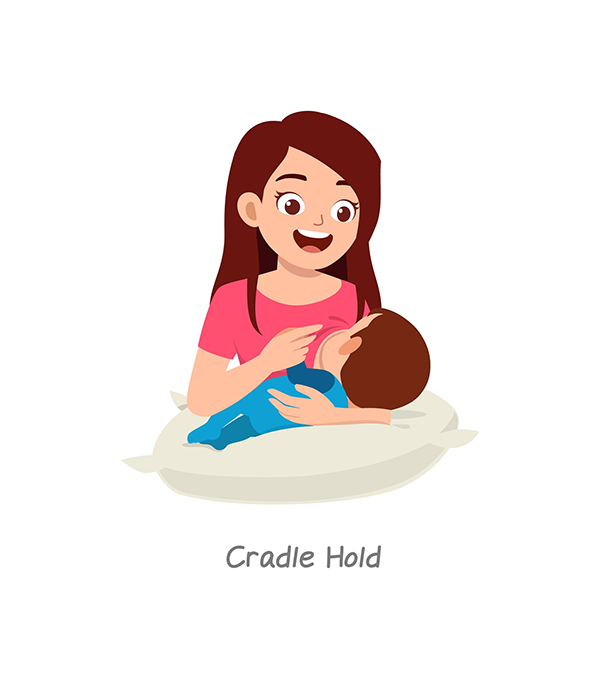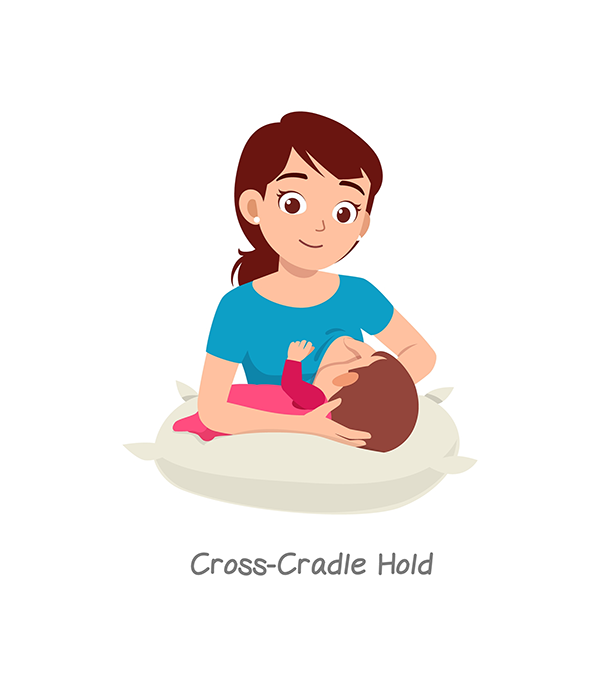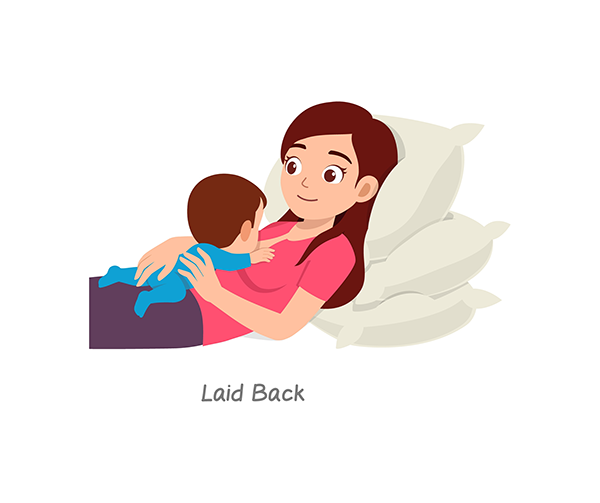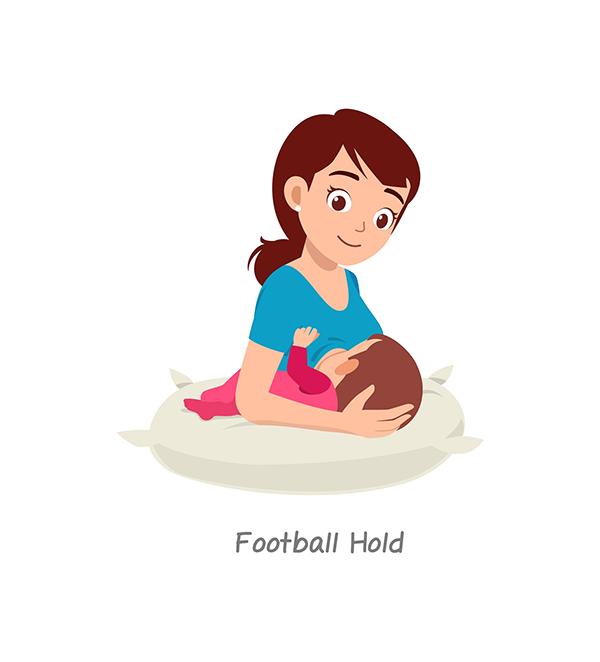
A Guide to the 5 Best Breastfeeding Positions for You and Baby
If you feel a cramping in your arm or an aching back while feeding your baby, these five breastfeeding positions can offer relief and turn feeding time into a more comfortable bonding experience. This guide will walk you through each hold to help you find the perfect fit for you and your little one.
1. Cradle Hold

The cradle hold is great for face-to-face bonding with your baby's head supported by the crook of your arm.
You've likely seen the cradle position for breastfeeding. This classic position helps keep your baby secure while allowing for plenty of eye contact, making it ideal for many full-term babies who have already established a good latch.
How to do it: Carry your baby on the same side as the breast you’re feeding from. Rest your baby's head in the crook of your elbow. Turn their body toward yours, with their tummy against your tummy. You can place a pillow on your lap for extra height and support.
2. Cross-Cradle Hold

The cross-cradle hold gives you more control to guide your newborn to a deep latch by supporting their head with your hand.
This position gives you more control when guiding your baby's head, making it one of the best breastfeeding positions for newborns or babies struggling to latch. It's also great for those recovering from a C-section.
A study in Sage Journals also found that the cross-cradle position leads to higher maternal comfort and better latch scores than the classic cradle hold.
How to do it: This position is the reverse of the cradle hold. If you’re feeding from your right breast, you’ll hold your baby with your left arm. Support the back of your baby's neck and shoulders with your palm, using your fingers to guide their head toward your breast gently. Your other hand is free to shape your breast, making latching easier.
3. Laid-Back Hold

The laid-back position uses gravity to help your baby find the breast and self-latch, which can help prevent sore nipples.
Also known as biological nurturing, the laid-back breastfeeding position is a game-changer for preventing sore nipples. It uses gravity to help your baby find the breast and latch on correctly.
A meta-analysis in BMC Pregnancy and Childbirth confirmed that the laid-back position significantly reduces nipple pain and trauma while promoting a correct latching position.
How to do it: Settle into a relaxed, semi-reclined position, on a bed or couch, with pillows supporting your back and shoulders. Place your baby tummy down on your chest and allow their natural reflexes to help them find the breast and latch on.
4. Side-Lying Hold

The side-lying position allows you to rest while feeding, making it ideal for nighttime sessions or for C-section recovery.
The side-lying breastfeeding position lets you feed your baby while resting, making it an ideal breastfeeding position for nighttime feedings. If you’re recovering from a C-section, it can also keep the pressure off your incision.
How to do it: Lie on your side facing your baby, tummy-to-tummy. Align their nose with your nipple and use your top hand to help them latch, then support their back with your arm. You can place a pillow under your head and another between your knees for comfort.
5. Football Hold (or Clutch Hold)

The football hold keeps your baby tucked at your side, which avoids pressure on a C-section incision and is great for twins.
The football hold breastfeeding position, also known as the clutch or rugby hold, is especially helpful after a C-section, since it keeps all pressure off your abdomen. It’s also beneficial if you have large breasts, flat nipples, or are feeding twins.
How to do it: Sit in a comfortable chair with pillows by your side. Hold your baby along your forearm, supporting their neck and shoulders with the palm of your hand. Tuck their legs under your arm. This side angle gives you a clear view of your baby’s latch.
Tips for Successful Breastfeeding in Any Position
No matter which hold you try, these tips will help ensure a correct breastfeeding position.
Lift your baby up, don't lean down
Avoid hunching over, which can cause back and neck pain. Instead, bring your baby to the level of your breast and not the other way around, states the American College of Obstetricians and Gynecologists (ACOG).
Look for signs of a good latch
Your baby's mouth should be wide open, with their top and bottom lips turned outward, not tucked in. According to UNICEF, you should see more of your areola above your baby’s top lip than below their bottom lip.
Ensure proper alignment
Your baby's head, neck, and spine should be in a straight line, not twisted. Their whole body should be facing yours in a tummy-to-tummy alignment (unless you're in the laid-back position). The American Academy of Pediatrics encourages proper alignment to help your baby latch on successfully.
FAQs About Breastfeeding Positions
Can I switch positions during a single feeding?
You can switch holds as often as you need to get comfortable or to help drain the breast more effectively. If you plan to feed from both sides in one session, feel free to use a different position for each. Just remember to unlatch your baby gently before you reposition them.
How can my partner help me get into a comfortable position?
Your partner can help by arranging pillows behind your back or under your arms before you start. They can also bring you a glass of water and then hand you the baby once you are settled and comfortable.
What if a position that used to work is suddenly uncomfortable?
This can happen as your baby grows bigger and stronger. A hold that was perfect for a newborn might not feel right with a 3-month-old. It could also be a sign of a clogged duct. Don't force a position that causes pain; switch to another hold that feels better for both of you.
If you continue to experience pain or have concerns about your baby's latch after trying any position, don't hesitate to contact a certified lactation consultant for personalized support.
Does the position affect gas or reflux in the baby?
Yes, it can. For babies prone to gas or reflux, more upright positions that allow gravity to keep milk down are often helpful. Try using the laid-back position or propping yourself up with extra pillows in a cradle hold so your baby isn't feeding while lying completely flat.
Remember, there isn’t a single "best" position. The ideal breastfeeding position is the one that feels right for you and your baby at that moment. Don't be afraid to experiment until you find what works for you. You can learn these techniques and also build on your skills with this guide to breastfeeding essentials.
Connect with other parents on the ParentTeam Moms and Dads Facebook group and share your own experiences with different breastfeeding positions!
References
American College of Obstetricians and Gynecologists. “Breastfeeding Your Baby.” ACOG, n.d. Accessed July 16, 2025. https://www.acog.org/womens-health/faqs/breastfeeding-your-baby
Bashiri, Azadeh, Lida Amiri-Farahani, Hamid Salehiniya, and Shefaly Pezaro. “Comparing the Effects of Breastfeeding in the Laid-Back and Cradle Position upon the Experiences of Primiparous Women: A Parallel Randomized Clinical Trial.” Trials 24, no. 1 (2023): 109. Accessed July 16, 2025. https://doi.org/10.1186/s13063-023-07143-0
Bhardwaj, Garima, and M. Smitha. “A Narrative Review of Strategies to Optimize Breastfeeding Among Mothers of Twins.” Cureus 16, no. 10 (October 31, 2024): e72792. Accessed July 16, 2025. https://doi.org/10.7759/cureus.72792
D’Souza, Smitha, Timi Thomas, and Shynee Paul. “Comparison of Two Breastfeeding Positions on Maternal Comfort and Infant Feeding Behaviors through Video Teaching among Postnatal Mothers.” J Health Allied Sci NU9 (2019): 104–15. Accessed July 16, 2025. https://www.thieme-connect.com/products/ejournals/pdf/10.1055/s-0039-3401966.pdf
Mayo Clinic. “Breastfeeding Positions.” Mayo Clinic, February 22, 2025. Accessed July 16, 2025. https://www.mayoclinic.org/healthy-lifestyle/infant-and-toddler-health/in-depth/breast-feeding/art-20546815
Mislu, Endris, Henok Kumsa, Melaku Wondaye Arage, Abetew Shitie, and Abenezer Adimasu. “Effective Breastfeeding Techniques and Associated Factors among Lactating Women: A Community-Based Study, North East Ethiopia.” Frontiers in Public Health 12 (2024): 1337822. Accessed July 16, 2025. https://doi.org/10.3389/fpubh.2024.1337822
Public Health Agency. “Attachment and Positioning.” Breastfed Babies, n.d. Accessed July 16, 2025. https://www.breastfedbabies.org/attachment-and-positioning












